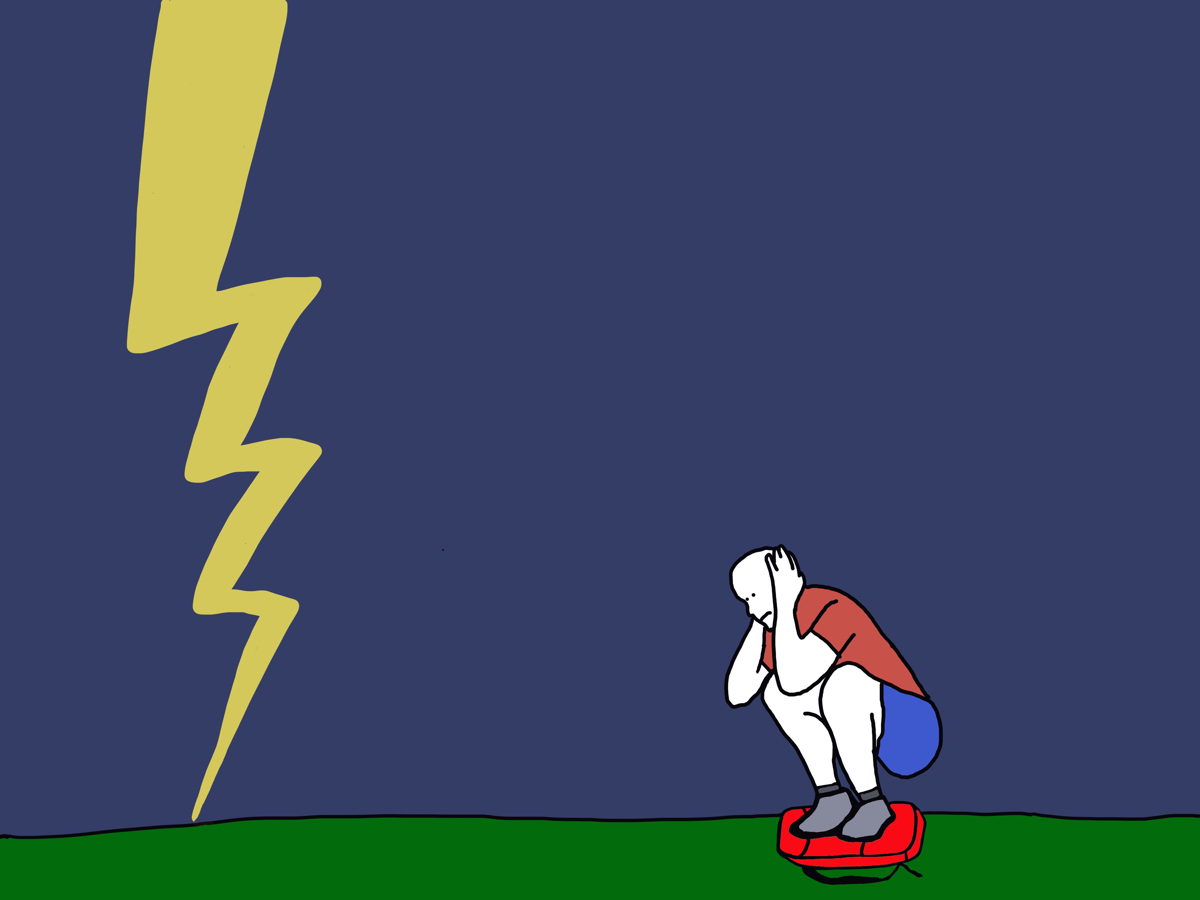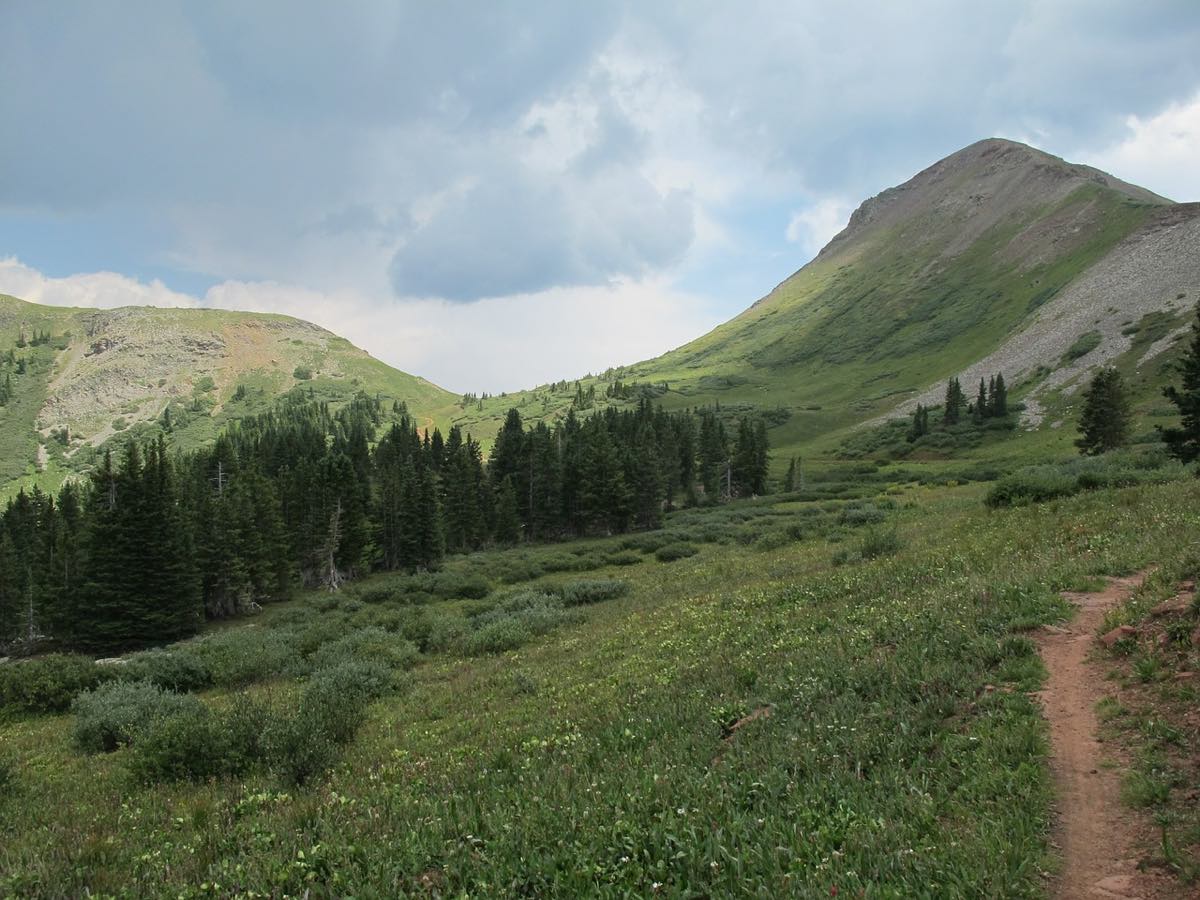“What do you want to do?” your friend asks.
You stare at the pass where the trail leads. Thunder rumbles again. You’re standing in an open meadow and there are dark clouds off to your left. You haven’t seen any lightning, but a loud peal of thunder just brought you and your running buddy to a stop. There’s a stand of trees to your left. You’re not sure what the other side of the pass looks like.
What do you want to do?
A. Continue on. There’s no lighting yet.
B. Take shelter in the stand of trees.
C. Get in the lightning position.
Choose your answer before reading further:
A. Continue on. There’s no lighting yet.
There is no thunder without lightning. When you hear thunder, you’re hearing the sound of the air expanding around hot lightning. So there is lightning around you. If you continue to the higher, exposed pass, you are putting yourself in a more dangerous place.
B. Take shelter in the group of trees.
Yup! There is no safe place outdoors in a thunderstorm. That’s why the National Weather Service’s maxim is: “When thunder roars, go indoors.” Being inside a building with walls is safe. Being inside a car with a metal roof is safe. Being outside is not safe. You can be struck by lightning if you’re hearing thunder. Since you can’t get inside, seek a less-unsafe location. Less-unsafe locations include an even stand of trees or low, rolling hills.
C. Get in the lightning position.
The lightning position is a last-ditch effort to protect yourself from ground current when you can’t move anywhere safer. When lightning hits a nearby object, the electricity radiates outward, and it will move through you if you’re in its path. This ground current is the cause of most lightning injures. The less of you that comes in contact with the current, the better. Also, the shorter the path the current takes through you, the better. Squatting with your feet together is provides a short path for the ground current. If you have a pad or hydration pack to squat on, it might insulate you from the current a bit.
Unfortunately, the reality is that most non-yoga-practicing runners cannot maintain this feet-together squat position for any amount of time. (Give it a try.) So go ahead and sit on your hydration pack with your feet and knees close together and your hands off the ground. Don’t touch your trekking poles. They don’t attract lightning, but they will conduct the ground current well. Keep in mind that being in the lightning position usually means you’ve made a series of bad decisions. It does not confer any safety. It might decrease the damage you’ll suffer from ground current though.

Here’s the lightning position, though putting your hands over your ears doesn’t necessarily help protect your hearing from thunder. (Though it could help you block out your situation and cope a little better. ;-) Image: Semi-Rad/Brendan Leonard
But in this scenario, you still have options. No need to cower and pray yet! And so the scenario continues.
As you’re considering what to do, a group of four runners catches up to you and continues on toward the pass. They look strong and experienced, and you decide to follow them. You have just fallen prey to what dangerous trap? Try to put a name to this trap before continuing.
Answer: The Social Facilitation Trap
The presence of other people increases risk-taking. You see other runners headed over the pass and decide it must be safe enough. Most lightning injuries in the wilderness are due to an unwillingness to acknowledge the danger and an unwillingness to change plans.
There are common human-factors traps that we fall prey to that impede our judgment. Sometimes we base our decisions on non-events, a lack of consequences for behavior in the past. You’ve run in similar conditions and haven’t been struck by lightning, so you’ll keep running now. Ian McCammon wrote a seminal paper in 2004 called Heuristic Traps in Recreational Avalanche Accidents: Evidence and Implications about the human factors that lead to avalanche deaths despite obvious signs of danger. The traps are easily transferable to lightning injuries. He calls this non-event trap the Familiarly Trap.
Also, the longer you keep running while it’s thundering, the harder it will be to stop and reevaluate your decision to keep running. McCammon calls this the Consistency Trap. It’s easier to choose to do something that is consistent with your past choices. “Well, I went over that last pass, so I will go over this one too.”
Another one that gets us in trouble is the Scarcity Trap. If waiting for a storm to pass means we might not finish a race, a race that’s hard to get into, or run the fast time we’re hoping for, we’ll often ignore lightning danger.
Or sometimes, we do what a more experienced runner recommends without question. “You count the time between the flash and the bang. Five seconds is one mile. The storm is five miles away. We’ll be okay.” This is known as the Expert Halo Trap. (Also, for the record, you can’t rely on this flash-bang estimation. Lightning can strike far from a storm. Also, it can be hard to pair the flash with the right bang especially in the mountains where sound swirls and bounces. Finally, storms move at different speeds.)
The scenario continues. You head up and over the pass. This sight greets you on the other side.
Lightning flashes as you hightail it down toward treeline. The four runners who passed you are not far ahead. Another lightning flash and a huge clap of thunder and you’re knocked to the ground. You pick yourself up slowly and look for your friend. He’s lying on his side about 10 feet from a large boulder. One of the other runners yells: “Spread out! Spread out!”
You should:
A. Keep running for the trees. You’re in danger.
B. Move away from your friend and get in the lightning position.
C. Go to your friend to see if he’s okay.
Decide what you’ll do before reading further.
A. Keep running for the trees. You’re in danger.
Sure, this is the safest choice. But let’s assume you’re the typical thoughtful and compassionate ultrarunner, so you don’t go with this one.
B. Move away from your friend and get in the lightning position.
If you’re in a dangerous place with a group, it makes sense to spread out and decrease the odds that everyone will be affected by the lightning. Like the lightning position, spreading a group out is a last-ditch move in a dangerous situation. How far you spread out depends on the terrain and the group’s ability to manage themselves. If someone doesn’t have rain gear, and splitting up means that person’s going to become hypothermic, it makes more sense to stay together and share an emergency blanket. You do want to keep within hearing distance of everyone. If you can get 20 feet from the next person, great. Again, spreading out doesn’t make you more safe. It just makes it more likely someone will be able to take care of someone else if they get hurt.
C. Go to your friend to see if he’s okay.
Of course, this is what you would do. “I think I dislocated my shoulder!” your friend yells. You ask him if anything else is hurt, and it becomes apparent he’s having trouble hearing you.
You:
A. Don’t touch him. He’s still carrying a current.
B. Help him up and hike fast toward the trees.
C. Use your hydration pack to splint his shoulder like Kilian Jornet’s at the 2017 Hardrock 100.
Decide what you’ll do before reading further.
A. Don’t touch him. He’s still carrying a current
People don’t carry a charge. Thankfully.
B. Help him up and hike fast toward the trees.
Yes! You are in an unsafe location. Get somewhere safer. Get to treeline and keep going until the trees are thick around you.
C. Use your hydration pack to splint his shoulder like Kilian’s at Hardrock.
After you get somewhere safe!
The four runners run uphill to meet you. (Because they’re more compassionate than smart.) “Did he get hit?” they ask. “I think the lightning hit the boulder and then splashed onto him,” you tell them.
Is there such a thing as splash lightning? Decide before reading further.
Yes, there is! Lightning can jump from one object to another. After ground-current injuries, splash lighting accounts for the most lightning injures, about 30 to 35%. Only a very few people are struck directly by lightning. Similarly, few people make the mistake of holding onto something conductive like a wire fence and get injured. (Cows are not as smart.)
What should you do with your trekking poles as you hike toward the trees?
A. Leave them behind and come back for them later.
B. Carry them in your hands. They don’t attract lightning.
C. Attach them to your pack.
Decide what you’ll do before reading further.
A. Leave them behind and come back for them later.
Unless you’re in the lightning position, there’s no need to part with your expensive poles. Place them a few feet away from you in the lightning position.
B. Carry them in your hands. They don’t attract lightning.
Metal doesn’t attract lightning, but it does conduct it well.
C. Attach them to your pack.
If you’re outside in a thunderstorm, you’re unsafe, and how you carry your trekking poles probably isn’t going to make much of difference. Still, having your poles attached to your pack and not touching your skin seems like a better choice.
You all make it into the trees. One of the other runners has his Wilderness First Aid certification and splints your friend’s shoulder. He tells you that hearing loss is not uncommon with lightning strikes. It’s often temporary. To pass the time as the storm continues, he reels off a list of other possible injuries your buddy could have sustained besides the trauma from being thrown and the ear injury:
- Death. His heart could have stopped. And we would have had to do CPR.
- Or he could have stopped breathing. So we’d have to breathe for him for a while.
- He could have been unconscious.
- Or had trouble walking.
- Or he could have some serious burns.
- Some folks lose their vision.
Thankfully, the storm seems to be abating and you interrupt the litany of possible, awful injuries to ask when it’d be safe to move on. The trail leaves the trees in about half a mile and runs through open meadows again.
How long should you wait after the last thunder clap to move on?
A. 15 minutes
B. 30 minutes
C. 1 hour
D. It depends
Answer before continuing.
B. 30 minutes
Thirty minutes is ideal. The storm is far-enough away at that distance to make a lightning strike unlikely. You might need to do a lot of warming exercises while you wait. Just because you’re not running doesn’t mean you can’t get a good workout. Burpees, jumping jacks, air squats, lunges, and core work will all keep you warm. Or this one.
After 30 minutes, you and your friend hike down the trail and, when you get cell reception, you call another friend to meet you at the closest trailhead and take you to a clinic. The scenario ends.
Prevention
So, how do we avoid the traps that make it likely we’ll expose ourselves to lightning danger when we’re running?
- Recognize that lightning is dangerous. If you hear thunder, you are unsafe. Go somewhere safe or at least safer. Get off the peak, ridge, or hill. Get away from the lone tree and the tree that’s clearly been struck by lightning before. Get out of the open meadow. Get off the shoreline. Get away from the wire fence. Water conducts electricity, so get out of puddles, off waterlogged ground too, and away from wet rock faces. And I hope you’re not tied to a wet rope.
- Look at the forecast and find out the typical weather patterns where you’re running. For example, in many places in the U.S. Mountain West in the summertime, there’s a thunderstorm around noon. Be done with your run before that.
- Identify the traps that will likely cause you to make a dangerous decision–and plan for how to avoid them. Do you and a particular running buddy always find yourselves in the lightning position or sprinting from a storm? Is that because you’re deferring to his judgment? How will you use your own judgment? Or do you make bad decisions during races because you’re focused on the competition or your time goals? How can you change that? Do you go along with a running group’s decision because you don’t want to cause trouble and do want to be accepted? How can you evaluate the hazard well despite that pressure?
For more information about lightning, watch this NOLS MythCrushers video.
Now, a pop quiz! Are you safe in an aid-station tent during a thunderstorm? (This an open-book quiz, so go back to the top of the article if you’re having trouble.)
Answer: No! A nice volunteer’s metal-roofed car would be a good option though.
[Author’s Note: Learn more about lightning injuries and how to prevent them and other wilderness first-aid skills with a two-day NOLS course. Thank you to Tod Schimelpfenig, NOLS Wilderness Medicine’s Curriculum Director and author of NOLS Wilderness Medicine, for his guidance and oversight of this series. Thanks also to graphic artist Brendan Leonard, the trail and ultrarunner of Semi-Rad fame, for his graphics collaboration in this article series.]
Call for Comments
- Have you been caught in a thunderstorm in a really unsafe location? If so, can you describe the location and how you managed the situation?
- Have you ever found yourself taking unnecessary lightning risks during races or for the sake of other goals? Looking back, can you articulate why you took that extra risk and what you think now of it?


